FAQ
- About UOB Personal Internet Banking
- Getting Started
- Accessing UOB Personal Internet Banking
- Username and Password
- Two-Factor Authentication
(2FA) - Security
- Q1. What is UOB Personal Internet Banking? UOB Personal Internet Banking is a specialised platform developed by the United Overseas Bank (UOB) to provide secure banking services over the Internet.
- Q2. Why should I choose to do my banking via UOB Personal Internet Banking? UOB Personal Internet Banking lets you access your bank accounts and carry out banking transactions online from anywhere with an internet connection. UOB Personal Internet Banking is a convenient means to manage your finances as it is available around the clock.
- Q3. What can I do with UOB Personal Internet Banking? With UOB Personal Internet Banking, you can perform a wide range of banking transactions, manage your UniAlerts, and access UOB Asset Management services.
- Q4. Is UOB Personal Internet Banking available 24 hours a day? Yes, you can use UOB Personal Internet Banking 24 hours a day, 7 days a week.
- Q5. How can I be sure that the Bank has received my banking instructions? When you successfully complete a transaction, you will be given a transaction reference number on-screen. This applies to all UOB Personal Internet Banking transactions except 'Enquiries'. It is important that you wait for the transaction reference number to appear on your screen before you change screens or exit from UOB Personal Internet Banking. Please take note of this transaction reference number for your future correspondences with the Bank.
- Q6. If my Internet connection is lost while I am transacting on UOB Personal Internet Banking, how will I know whether my transaction has been effected? Please check if your transaction has been effected in 'Online Transaction History' under the 'Account Services' feature.
- Q7. Is there a fee or cost for using UOB Personal Internet Banking?
No, UOB Personal Internet Banking is currently a free service. There is no fee charged for bill payment, fund transfer or performing an enquiry.
However, charges apply for the following transactions:
-
Manage My Accounts
- Stop Cheque: S$10 for each cheque or cheque range stopped
- Cheque Book Request: S$10 per cheque book
-
Remittance Services
- Cashier's Order Purchase Commission: S$3
- Demand Draft Purchase Commission: 1/16% of transaction amount (minimum S$10.00 and maximum S$100.00)
- International Telegraphic Transfer (TT) and Local SGD Telegraphic Transfer (MEPS)
Commission: 1/16% of transaction amount (minimum S$10.00 and maximum S$100.00)^
^ Cable charges and agent charges, if any, still apply
-
IPO Application
- IPO Application: S$2
-
Manage My Accounts
- Q8. What system setup do I need in order to use UOB Personal Internet Banking?
UOB Personal Internet Banking is a specialised platform developed by the United Overseas Bank (UOB) to provide secure banking services over the Internet.
Our recommended system setup for accessing UOB Personal Internet Banking is as follows:-
PC configuration:
- With Internet connection
-
Web Browser*
- Internet Explorer 6.X or 7.0, Firefox 3.03, Safari 3
-
Macintosh configuration:
- Mac (Leopard), Mac (Tiger)
- Mac (Leopard), Mac (Tiger)
- Web Browser*
- Safari 3
-
iPhone & iPad configuration
- iPhone 4 Safari browser on iOS 4.1
- iPad Safari browser on iOS 3.2.2
UOB Personal Internet Banking employs 128-bit Secure Socket Layer (SSL), which is internationally recognised as the highest standard in commercially available encryption technology. 128-bit Secure Socket Layer (SSL) is adopted by banks in Singapore and financial institutions worldwide. Your browser must support 128-bit encryption to enable your access to UOB Personal Internet Banking. To check your browser's encryption level, follow the steps below:- Microsoft Internet Explorer
- Select 'Help' from the Internet Explorer menu bar.
- Select 'About Internet Explorer' from the drop-down menu.
- The 'About Internet Explorer' dialog box will provide information on your browser version and encryption level.
- Firefox version
- Select 'Help' from the Netscape menu bar.
- Select 'About Mozilla Firefox' from the drop-down menu.
- The 'About Mozilla Firefox' dialog box will provide information on your browser version.
-
PC configuration:
- Q9. How do I enable Java on my browser?
To enable these features on your browser, follow these steps:
For Internet Explorer:- In Internet Explorer, on the 'Tools' menu, click 'Internet Options'.
- On the 'Privacy' tab, ensure that the slider is at the Medium security level.
- Click the 'Advanced' tab. Scroll down. Ensure that either of the following is checked:
- Under Java (IBM), 'Use Java 2... ‹ applet › (requires restart)
OR
- Under Java (Sun), 'Use JRE... ‹ applet › (requires restart)'. - Click 'OK' button to exit the dialogue box.
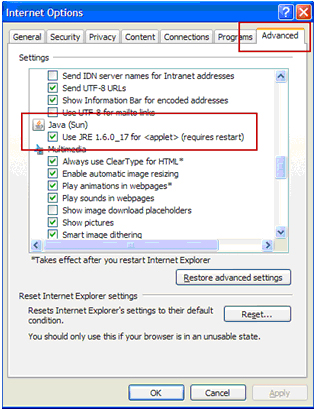
For Mozilla Firefox:
- In Firefox, on the 'Tools' menu, click 'Options'
- Click on 'Content' tab and ensure that 'Enable Java' is checked
- Click 'OK' button to exit the dialogue box
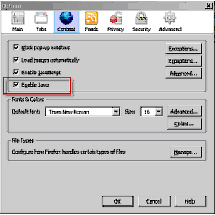
- Q10. Why must my browser be Java-enabled? Aside from 128-bit SSL, UOB Personal Internet Banking uses a Java applet for added security in encrypting your Password before it is transmitted to the Bank. Without being Java-enabled or having an updated JRE (Java Runtime Environment) in your browser, the applet will not work and you will not be able to login to UOB Personal Internet Banking.
- Q11. How do I check the Java version installed on my browser?
- Launch your Internet browser
- Click "Tools" tab and select "Sun Java Console" from the menu
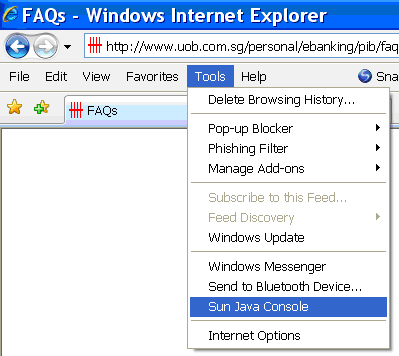
- Check that JRE version is at least version 1.3.1 and higher
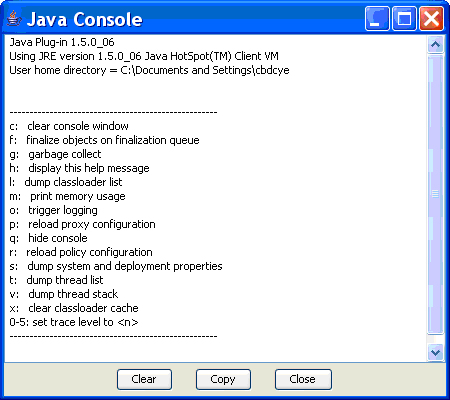
- Q12. How do I know if my browser is Java-enabled?
Check that your browser settings comply with our recommendations. If JRE is outdated, corrupted or not installed in your system, you will not be able to enter your password for login to UOB Personal Internet Banking. For example, you will not be able to move the blinking line cursor to the password field.
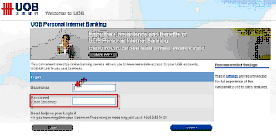
- Q13. What must I do to install Java on my browser?
Please follow the steps below to install the latest version of JRE.
- Go to www.java.com/getjava
- Click "Free Java Download". The site will detect your browser/operating system and present a compatible Java program for download and installation
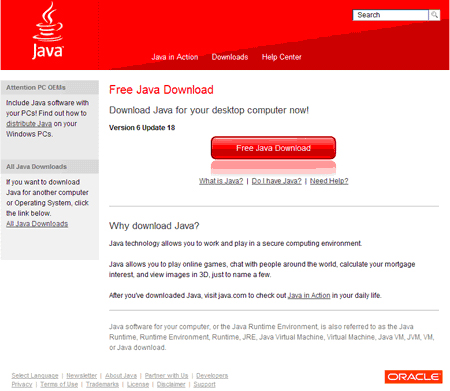
- Click "Installation Instructions" if you require a step-by-step installation guide
- To download the software, click "Free Java Download" and the installation process will start to run

- Once installation is completed, perform steps in Q11 to check version of JRE
- Restart the browser and login to UOB Personal Internet Banking
- Q14. Who can use UOB Personal Internet Banking?
To use UOB Personal Internet Banking, you need to have at least one of the following accounts* with the UOB Group:
- Campus Account
- Current Account
- Global Currency Account
- i-Account
- FlexiDeposit Account
- Savings Account
- Junior Savers Account
- Uniplus Account
- TX Account
- Foreign Currency Fixed Deposit
- Singapore Dollar Time/Fixed Deposit
- CashPlus
- Loan Accounts
- UOB-CPF Investment Account
- Credit Card
- Debit Card
- Unit Trust Account
- High Yield Account
*You would need to be either a personal or joint-alternate ('AND/OR') account holder. Note: Joint/And accounts with multiple signing conditions cannot be linked. All UOB Asset Management joint accounts cannot be linked for online access. - Q15. I am a UOB customer, how do I apply for UOB Personal Internet Banking access?
These are the easy ways to apply for UOB Personal Internet Banking:
- UOB Branch
Register at any UOB Branch and receive your temporary Username and Password immediately. - UOB ATMs
Register at any UOB ATM with your UOB ATM Card or Credit Card and receive your temporary Username and Password immediately.
Select Cashcard/Other Trans/NETS FlashPay > Other Transactions > Internet/Phone Banking/UOB Mobile > Internet Banking/UOB Mobile > Apply Now - Online application
Submit your personal details online (including your preferred Username and Password), then print and mail the online form to us for our activation.
- UOB Branch
- Q16. I am not a UOB customer. How do I apply for UOB Personal Internet Banking access? To access UOB Personal Internet Banking, you must have an account with the UOB Group. You can visit any UOB Group Branch to open an account and at the same time, apply for UOB Personal Internet Banking.
- Q17. How do I activate my access to start using UOB Personal Internet Banking services?
Upon receipt of the Username and Password mailers, you can activate your access in any one of the following ways:
- At any UOB ATM with your UOB ATM Card or Credit Card.
- Select Cashcard/Other Trans/NETS FlashPay > Other Transactions > Internet/Phone Banking/UOB Mobile > Internet Banking/UOB Mobile > UserName Activation
- Your username will be shown on the screen. Select 'Confirm' to activate your access.
- Following the activation of your Username, you can login immediately to UOB Personal Internet Banking with your Username and Password.
- Sign on the acknowledgement slip printed at the bottom of the username mailer and post it back to the Bank or hand it to any UOB Group Branch.
- At any UOB ATM with your UOB ATM Card or Credit Card.
- Q18. Can I have more than one Username? You can only have one set of Username and Password.
- Q19. Can I change my UOB Personal Internet Banking Username? Once you have selected your preferred UOB Personal Internet Banking Username, you will not be able to change it. For security reasons, choose a Username which will not be easily known to a third party.
- Q20. Can I change my UOB Personal Internet Banking Password? Yes, you can do so by selecting 'Customer Service' > 'Change Password' after you login to UOB Personal Internet Banking. As a security measure, change your Password periodically. To learn more about safeguarding your password, please refer to our security recommendations.
- Q21. I have forgotten my UOB Personal Internet Banking Username. What should I do?> If you have forgotten your Username, please call our 24-hour hotline 1800 222 2121 (or +65 6222 2121 when calling from overseas) for assistance.
- Q22. I have forgotten my UOB Personal Internet Banking Password. How can I get it replaced?
You can replace your Password in one of the following ways:
- Visit any UOB Branch
Simply approach any of our friendly UOB branch staff for assistance. -
Perform a password change at any UOB ATM
Replace your Password immediately by accessing any UOB ATM.
At the ATM, select Cashcard/Other Trans/NETS FlashPay > Other Transactions > Internet/Phone Banking/UOB Mobile > Internet Banking/UOB Mobile > Password Replacement
Print, complete and mail the UOB Personal Internet Banking - Information Update Form (PDF: 193KB) to us. Your new Password will be sent to you by post. - Our Website or call centre doesn't facilitate your UOB Personal Internet Banking Password replacement.
- Visit any UOB Branch
- Q23. What is the Two-Factor Authentication and how does it work? Two-Factor Authentication (2FA) provides an additional layer of security for verifying the identity of a UOB Personal Internet Banking customer. With Two-Factor Authentication, UOB Personal Internet Banking customers will be required to provide a unique One-Time Password (OTP) in addition to the current Username and Password upon login.
- Q24. What is UOB's approach to Two-Factor Authentication? UOB has two authentication modes to provide flexibility and convenience to our customers. SMS-OTP and Token-OTP authentication have been offered since 10 December 2006.
- Q25. What is SMS-OTP?
SMS-OTP is a one-time password delivered to the mobile phone of a UOB Personal Internet Banking customer. For this option, the customer's mobile phone number must be registered with the Bank.
Note:
Receipt of SMS is dependent on your mobile network operator's roaming service.
If you are overseas, you may wish to consult them to find out more about the delivery of the SMS to you. - Q26. What is Token-OTP? Token-OTP is a one-time password obtained from a security device (Token) issued to UOB Personal Internet Banking customers.
- Q27. Is Two-Factor Authentication compulsory and will I be affected by Two-Factor Authentication? As Two-Factor Authentication is compulsory, it will apply to all UOB Personal Internet Banking customers.
- Q28. How will I be affected by Two-Factor Authentication? UOB Personal Internet Banking customers are required to enter an additional One-Time Password (OTP) when performing online transactions.
- Q29. Why is Two-Factor Authentication important? What does it do for me? Two-Factor Authentication allows the Bank to provide additional security to Internet Banking customers. It ensures that only authorised customers can gain access to account information and transact securely.
- Q30. When do I need to use the One-Time Password (OTP)?
You are required to use the One-Time Password (OTP) when performing any of the following transactions:
- Login to UOB Personal Internet Banking
- Setting up Funds Transfer arrangement to third party UOB accounts
- Setting up Funds Transfer arrangement to other banks
- Setting up Remittance arrangement
- Q31. What if I have enabled Two-Factor Authentication but do not have my mobile phone or Token with me; and I urgently need to use Personal Internet Banking? In this case, you will be able to login to UOB Personal Internet Banking using your Username and Password to perform balance enquiries only. You will not have access to perform transactional activities.
- Q32. I can only view some of my UOB accounts online. I would like to view my other UOB accounts too. How do I go about it?
Your delinked UOB Personal/Joint-OR account number (except Joint UOBAM, SRS accounts, Custody Account) will be reflected in UOB Personal Internet Banking under “Link Account” page for your convenience to have them linked online.
Note: Joint/And accounts with multiple signing conditions cannot be linked. All UOB Asset Management joint accounts cannot be linked for online access. - Q33. I have only one account with the UOB Group. Can I apply for another one online? Yes, you can if you have a statement-based retail account. You can open a Current Account, Campus Account, i-Account, FlexiDeposit Account and Uniplus Account through UOB Personal Internet Banking. To do so, simply click on 'Online Applications' > 'Savings/Current Account' upon login.
- Q34. Can I link my joint accounts to my Username? Yes, you can do so if your joint account requires only one signature for the authorisation of transactions. Joint/And accounts with multiple signing conditions, and all UOB Asset Management joint accounts cannot be linked for online access.
- Q35. Can I transfer funds to third-party accounts in UOB or other banks in Singapore?
Yes, you can transfer funds to third-party accounts in UOB or other banks in Singapore through UOB Personal Internet Banking.
To do so, you have to login to UOB Personal Internet Banking to make a funds transfer arrangement for the account you wish to transfer funds to. You will only be required to make a funds transfer arrangement ONCE to enable you to transfer funds subsequently to the payee.
When making a funds transfer arrangement, you will be required to enter a One-Time Password (OTP) upon clicking the 'Confirm' button. Once this is done, the new payee will be activated instantly and you can transfer funds to them immediately. - Q36. Why is One-Time Password (OTP) required?
This is an additional authentication required for login to UOB Personal Internet Banking, funds transfer arrangement and purchase of cashier's order/demand draft to new beneficiaries. With this added security feature, you can enjoy greater peace of mind knowing that new payees nominated for funds transfers and new beneficiaries for cashier's order/demand draft purchase have been authorised by you.
For more information about OTP, please read our FAQ. - Q38. How do I terminate my Username?
You can visit any UOB Group Branch and complete Part A of the UOB Personal Internet Banking
- Information Update Form. Please allow five business days for your Username termination request to be effective.
If you do not wish the Bank to effect these instructions, please login to UOB Personal Internet Banking and delete these instructions.
If you wish to access UOB Personal Internet Banking service again after your Username has been terminated, you can re-apply for the service using a different Username.
- Q39. How can I be sure that banking online at UOB Personal Internet Banking is secure?
UOB Personal Internet Banking has a system that provides a high standard of security for banking over the Internet. This security system safeguards the confidentiality of your personal account information and banking transactions employs:
- Multiple levels of firewalls
- 128-bit Secure Sockets Layer (SSL) encryption – currently recognised internationally to be of the highest standard in encryption technology commercially available
- A two-tier authentication technology that uses a Username and Password, as well as a One-Time Password obtained via a token or the customer's mobile phone.
- Q40. How can I be certain that the web page I am on is secure? Upon login to UOB Personal Internet Banking, check that the website address at the top status bar of your browser changes from http:// to https:// and that a security icon (symbolised by a lock) appears at the bottom status bar of your browser. This indicates that the web page you are on is equipped with encryption technology. You can double click on the security icon to view information pertaining to the security certificate for the web page.
- Q41. What additional steps can I take to make my online banking experience even more secure?
While the Bank has taken steps to keep your account information secure, you, as a registered user, also play an important role in maintaining the security of your account information.
- Keep your UOB Personal Internet Banking Username and Password confidential. Memorise them and NEVER write them anywhere or reveal them to anyone. Please note that no staff member of the UOB Group should ever ask you for your UOB Personal Internet Banking Username and Password for whatever reasons.
- You should also change your Password from time to time, using the 'Change Password' feature available on UOB Personal Internet Banking
- Before you exit from UOB Personal Internet Banking, always clear your browser's disk cache, especially if you are accessing your account from public terminals. This will prevent your account information from being stored on the terminals. Instructions on how to clear your browser's disk cache are provided on the screen when you select 'Exit' on the UOB Personal Internet Banking website.
- You should always log out of UOB Personal Internet Banking before moving on to other websites
- Install an effective personal firewall1 on your PC together with anti-virus2 and anti-Trojan horse3 software to safeguard your PC from viruses and malicious programmes. Viruses and malicious programmes may damage and/or destroy your personal data if undetected. Some can even capture your password keystrokes or other personal information, and these details can be transmitted to another person without your consent.
1Personal Firewall
Personal firewalls serve two basic functions. They protect your system from unsolicited scans coming from the Internet and usually offer outbound controls as well. An inbound scan will look for and block any uninvited commands, instructions, programmes or messages from entering your system, while outbound controls will look for and block unfamiliar programmes (like viruses and Trojan horses) from trying to send out messages from your computer.
2Anti-Virus Software
Anti-virus software scan your hard disk to locate and remove viruses. To some extent, these products can scan for and possibly remove worms and Trojan horses.
3Anti-Trojan Horse Software
Anti-Trojan horse software can identify and remove more programmes that act like Trojan horses than anti-virus software can. A Trojan horse programme is usually an innocent programme or utility that you might download on your PC. However, behind the programme's perceived usefulness lurks a function that allows it to damage your computer or steal your personal information. You can refer to our Privacy & Security for more information on Your Role In Safeguarding Your Personal Data And Account Information. - Q42. What should I do if I lose my Password for UOB Personal Internet Banking? If you lose your UOB Personal Internet Banking Password, suspect that the confidentiality of your Password has been compromised, or notice any unusual activity with your account(s), you should notify the Bank immediately by calling 1800 222 2121 (24 hours, toll-free).
- Q43. How do I clear my disk cache?
To clear your disk cache, just follow these steps:
For IE 5.0 and higher:- Select 'Tools' from the Menu Bar.
- Select 'Internet Options'.
- Select 'General' tab.
- Click the 'Delete Files' button under Temporary Internet files.
- Click 'OK' to exit the dialogue box.
For Navigator 4.5 and higher:- Select 'Edit' from the Menu Bar.
- Select 'Preferences'.
- Expand 'Advanced' to show 'Cache'.
- Select 'Cache'.
- Click on the 'Clear Disk Cache Now' button and answer yes.
- Click on the 'Clear Memory Cache Now' button and answer yes.
- Click 'OK' to exit the dialogue box.
